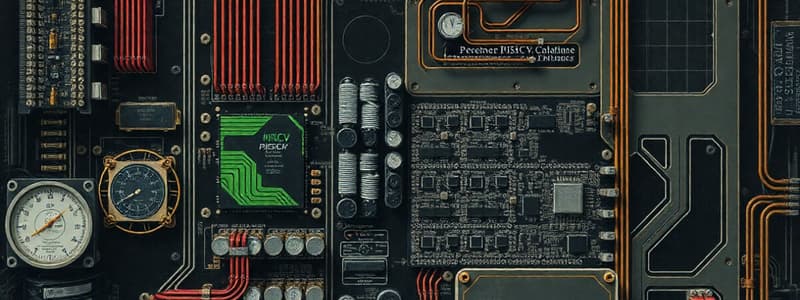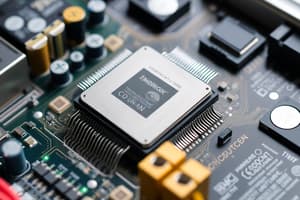Podcast
Questions and Answers
What role do parameters play in a procedure?
What role do parameters play in a procedure?
- They provide an interface between the procedure and the program. (correct)
- They multiply the execution speed of the code.
- They store the results of the procedure.
- They define the scope of the procedure.
Which step is NOT part of the procedure execution process?
Which step is NOT part of the procedure execution process?
- Return control to the point of origin.
- Transfer control to the procedure.
- Delete all previous data. (correct)
- Perform the desired task.
How can procedures be described in terms of abstraction?
How can procedures be described in terms of abstraction?
- They are specific to one programming language.
- They are only needed for large programs.
- They simplify programming by hiding the complexity. (correct)
- They require all data to be visible at all times.
In RISC-V software, what is the purpose of registers x10–x17?
In RISC-V software, what is the purpose of registers x10–x17?
What is the function of a procedure in programming?
What is the function of a procedure in programming?
What is the primary purpose of the jump-and-link instruction in RISC-V?
What is the primary purpose of the jump-and-link instruction in RISC-V?
In the context of RISC-V assembly language, what does the return address refer to?
In the context of RISC-V assembly language, what does the return address refer to?
Which instruction is used to return from a procedure in RISC-V?
Which instruction is used to return from a procedure in RISC-V?
What role does the caller have in the procedure call process?
What role does the caller have in the procedure call process?
What is stored in register x1 during a jump-and-link instruction?
What is stored in register x1 during a jump-and-link instruction?
What does the procedure fact return when the parameter n is less than 1?
What does the procedure fact return when the parameter n is less than 1?
What is the purpose of the instruction 'addi sp, sp, -8' in the RISC-V assembly code?
What is the purpose of the instruction 'addi sp, sp, -8' in the RISC-V assembly code?
In the context of the fact procedure, what does the instruction 'bge x5, x0, L1' check?
In the context of the fact procedure, what does the instruction 'bge x5, x0, L1' check?
What value is stored in register x10 before the procedure fact returns?
What value is stored in register x10 before the procedure fact returns?
How does the recursive call to the fact procedure handle the argument n?
How does the recursive call to the fact procedure handle the argument n?
Which register is used to save the return address when entering the fact procedure?
Which register is used to save the return address when entering the fact procedure?
What happens immediately after the instruction 'addi x10, x0, 1' is executed?
What happens immediately after the instruction 'addi x10, x0, 1' is executed?
What does the instruction 'jal x1, fact' do in the assembly code?
What does the instruction 'jal x1, fact' do in the assembly code?
Before executing the pop instructions, which registers could be loaded back into the original state?
Before executing the pop instructions, which registers could be loaded back into the original state?
How is the value of n modified before the recursive call?
How is the value of n modified before the recursive call?
Flashcards are hidden until you start studying
Study Notes
Procedures in Computer Hardware
- Procedures (or functions) are programming tools that improve code readability and reusability.
- They enable programmers to focus on individual tasks, using parameters as interfaces for data exchange and result returns.
- Procedures implement abstraction in software, acting like self-contained modules that perform tasks without disturbing other parts of the program.
- Six steps in procedure execution: parameter placement, control transfer, resource acquisition, task execution, result placement, and control return to the point of origin.
RISC-V Procedure Calling Convention
- RISC-V utilizes 32 registers, with x10-x17 dedicated to parameter passing or return values and x1 for storing the return address.
- The
jal(jump-and-link) instruction branches to a procedure's address and saves the return address in x1. - The return address allows procedures to be called from multiple program locations ensuring successful return.
- The
jalr(jump-and-link register) instruction uses the address in x1 to return to the calling program. - The calling program (caller) provides parameters in registers x10-x17 and uses
jalto branch to the procedure (callee).
Recursive Procedure Example (Factorial Calculation)
- A recursive C factorial function is compiled into RISC-V assembly code.
- The stack is used to save the return address and the function's argument (n).
- Conditional branching occurs based on the value of n. If n < 1, the function returns 1. If n ≥ 1, the argument is decremented and the function calls itself recursively.
- The stack is used to manage the nested function calls. The results are returned through register x10.
Stack Allocation in Procedures
- Stack allocation is illustrated, considering states before, during, and after a procedure call.
- The frame pointer (FP or x8) points to the beginning of the procedure's stack frame, while the stack pointer (SP) points to the top of the stack.
- The stack frame accommodates saved registers, return addresses, local variables, and other data.
- The frame pointer offers a stable reference point for accessing variables, even as the stack pointer changes.
- If no local variables exist on the stack within a procedure, the compiler omits frame pointer setup and restoration to optimize processing speed.
Memory Allocation in RISC-V (Linux)
- RISC-V memory is divided into segments: stack, heap, static data segment, text segment, and reserved memory.
- The stack grows downwards from high memory addresses.
- The text segment (machine code) resides at the start of low memory.
- Static data (constants, static variables) is placed above the text segment.
- The heap, used for dynamic data structures, is positioned next, growing upwards towards the stack. This arrangement allows efficient memory usage.
Studying That Suits You
Use AI to generate personalized quizzes and flashcards to suit your learning preferences.




